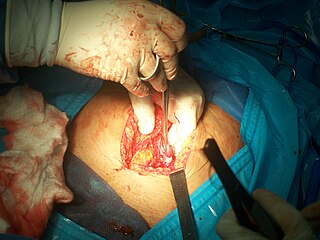Related Research Articles

The endometrium is the inner epithelial layer, along with its mucous membrane, of the mammalian uterus. It has a basal layer and a functional layer: the basal layer contains stem cells which regenerate the functional layer. The functional layer thickens and then is shed during menstruation in humans and some other mammals, including apes, Old World monkeys, some species of bat, the elephant shrew and the Cairo spiny mouse. In most other mammals, the endometrium is reabsorbed in the estrous cycle. During pregnancy, the glands and blood vessels in the endometrium further increase in size and number. Vascular spaces fuse and become interconnected, forming the placenta, which supplies oxygen and nutrition to the embryo and fetus. The speculated presence of an endometrial microbiota has been argued against.

Emergency contraception (EC) is a birth control measure, used after sexual intercourse to prevent pregnancy.

Tubal ligation is a surgical procedure for female sterilization in which the fallopian tubes are permanently blocked, clipped or removed. This prevents the fertilization of eggs by sperm and thus the implantation of a fertilized egg. Tubal ligation is considered a permanent method of sterilization and birth control.

Ovulation is the release of eggs from the ovaries. In women, this event occurs when the ovarian follicles rupture and release the secondary oocyte ovarian cells. After ovulation, during the luteal phase, the egg will be available to be fertilized by sperm. In addition, the uterine lining (endometrium) is thickened to be able to receive a fertilized egg. If no conception occurs, the uterine lining as well as the egg will be shed during menstruation.

Levonorgestrel is a hormonal medication which is used in a number of birth control methods. It is combined with an estrogen to make combination birth control pills. As an emergency birth control, sold under the brand names Plan B One-Step and Julie, among others, it is useful within 72 hours of unprotected sex. The more time that has passed since sex, the less effective the medication becomes, and it does not work after pregnancy (implantation) has occurred. Levonorgestrel works by preventing ovulation or fertilization from occurring. It decreases the chances of pregnancy by 57 to 93%. In an intrauterine device (IUD), such as Mirena among others, it is effective for the long-term prevention of pregnancy. A levonorgestrel-releasing implant is also available in some countries.
Gamete intrafallopian transfer (GIFT) is a tool of assisted reproductive technology against infertility. Eggs are removed from a woman's ovaries, and placed in one of the Fallopian tubes, along with the man's sperm. The technique, first attempted by Steptoe and Edwards and later pioneered by endocrinologist Ricardo Asch, allows fertilization to take place inside the woman's uterus.
The Yuzpe regimen is a method of emergency contraception that uses a combination of ethinyl estradiol and levonorgestrel, specifically 1 mg of norgestrel and 100 mcg of ethinyl estradiol ASAP and again in 12 hrs. It is less effective and less commonly used than a larger dose of levonorgestrel alone, a dose of ulipristal acetate, or insertion of a copper intrauterine device. It is designed to be used within 72 hours of unprotected sexual intercourse because it works by inhibiting ovulation.

Georgeanna Seegar Jones was an American reproductive endocrinologist who with her husband, Howard W. Jones, pioneered in vitro fertilization in the United States.

Desogestrel is a progestin medication which is used in birth control pills for women. It is also used in the treatment of menopausal symptoms in women. The medication is available and used alone or in combination with an estrogen. It is taken by mouth.

Norgestrel is a progestin which is used in birth control pills sold under the brand name Ovral in combination with the estrogen ethinylestradiol and Opill by itself. It is also used in menopausal hormone therapy. It is taken by mouth.
Controlled ovarian hyperstimulation is a technique used in assisted reproduction involving the use of fertility medications to induce ovulation by multiple ovarian follicles. These multiple follicles can be taken out by oocyte retrieval for use in in vitro fertilisation (IVF), or be given time to ovulate, resulting in superovulation which is the ovulation of a larger-than-normal number of eggs, generally in the sense of at least two. When ovulated follicles are fertilised in vivo, whether by natural or artificial insemination, there is a very high risk of a multiple pregnancy.
Poor ovarian reserve is a condition of low fertility characterized by 1): low numbers of remaining oocytes in the ovaries or 2) possibly impaired preantral oocyte development or recruitment. Recent research suggests that premature ovarian aging and premature ovarian failure may represent a continuum of premature ovarian senescence. It is usually accompanied by high FSH levels.
Transvaginal oocyte retrieval (TVOR), also referred to as oocyte retrieval (OCR), is a technique used in in vitro fertilization (IVF) in order to remove oocytes from the ovary of a woman, enabling fertilization outside the body. Transvaginal oocyte retrieval is more properly referred to as transvaginal ovum retrieval when the oocytes have matured into ova, as is normally the case in IVF. It can be also performed for egg donation, oocyte cryopreservation and other assisted reproduction technology such as ICSI.
Combined injectable contraceptives (CICs) are a form of hormonal birth control for women. They consist of monthly injections of combined formulations containing an estrogen and a progestin to prevent pregnancy.
Carlos Sueldo is a physician and professor of obstetrics and gynaecology (OB/GYN) for the University of California, San Francisco. Dr. Sueldo is also the founder (1984) and present Director of the in vitro fertilization IVF Fertility Center. Dr. Sueldo concurrently serves as the Scientific Director at the Center for Gynecology and Reproduction (CEGYR) in Buenos Aires, Argentina, and is a founding board member of the World Endometriosis Research Foundation.
The following outline is provided as an overview of and topical guide to obstetrics:
Endometriosis and its complications are a major cause of female infertility. Endometriosis is a dysfunction characterized by the migration of endometrial tissue to areas outside of the endometrium of the uterus. The most common places to find stray tissue are on ovaries and fallopian tubes, followed by other organs in the lower abdominal cavity such as the bladder and intestines. Typically, the endometrial tissue adheres to the exteriors of the organs, and then creates attachments of scar tissue called adhesions that can join adjacent organs together. The endometrial tissue and the adhesions can block a fallopian tube and prevent the meeting of ovum and sperm cells, or otherwise interfere with fertilization, implantation and, rarely, the carrying of the fetus to term.

Dr. Abayomi Ajayi is a Nigerian obstetrician/gynecologist.
Peter C. Klatsky is a Doctor of Medicine specialized in reproductive endocrinology and infertility and an assistant professor at the Albert Einstein College of Medicine. Klatsky who is board certified in his specialty as well as in obstetrics and gynaecology, is also the Founder and CEO of Spring Fertility Management Llc, a San Francisco Bay Area fertility company. Klatsky is a member of the Council on Foreign Relations, a nonprofit think tank specializing in U.S. foreign policy and international affairs.
Norbert Gleicher is an American obstetrician-gynecologist active in obstetrical practice, in vitro fertilization, reproductive endocrinology, and reproductive immunology. He is a fellow of the American College of Obstetricians and Gynecologists (FACOG) and the American College of Surgeons (ACS) and currently serves as president, medical director and chief scientist of the Center for Human Reproduction (CHR) in New York City, a clinical fertility center that he founded in 1981. Simultaneously, he is President of the Foundation for Reproductive Medicine, a not-for-profit research foundation. Gleicher maintains additional academic appointments at Rockefeller University, and Medical University of Vienna.
References
- ↑ RengelMarian (2000). Encyclopedia of Birth Control. Greenwood Publishing Group, ISBN 9781573562553
- ↑ Haspels AA (1994). Emergency contraception: a review. Contraception . 1994 Aug;50(2):101-8. PMID 7956209
- ↑ Yuzpe AA, Smith RP, Rademaker AW. A multicenter clinical investigation employing ethinyl estradiol combined with dl-norgestrel as postcoital contraceptive agent. Fertil Steril 1982;37:508-513 PMID 7040117